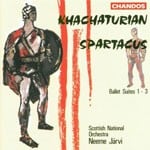Spartacus
(Spartakus) - Suite No. 2 from the ballet (1950-54, rev.1960/68)3(III=picc).2.corA.2.bcl.2-4.3.3.1-timp.perc:tgl/wdbl/tamb/D/BD/cyms/tamt/xyl-hp-pft-cel-str
Abbreviations (PDF)
VAAP
1.Adagio of Spartacus and Phrygia 2.Entrance of the Merchants (Dance of the Romans) 3.Entrance of Spartacus 4.Dance of the Pirates
Ever since being used as the theme tune to BBC TV’s The Onedin Line, the Adagio from Spartacus – originally danced by the hero and his wife Phrygia – has been an international hit and the single best-known number of the ballet. But how many people know the original full ballet score, scored for a large orchestra and chorus? And how much more powerful that Adagio is when heard in context!
For, unlike Gayaneh, Spartacus is not merely a ballet of dance ‘numbers’, but Khachaturian’s most ambitious stage work, in which he emulated the symphonic style of the best ballets of Tchaikovsky and Prokofieff (particularly of Romeo and Juliet). That said, the entire score is probably best heard accompanying the ballet itself. In concert, highlights from the ballet are often programmed, including four orchestral suites selected by the composers and scenes taking the form of symphonic pictures.
A ‘heavier’ suite with longer movements than its predecessor, Suite No.2 focuses mainly on Spartacus himself, but includes the much-beloved Adagio of Spartacus and Phrygia, which is often excerpted and included with performances of Suite No.1. The other movements include Entrance of the Merchants, which contrasts the decadent Romans (very song-and-dance types!) with the forlorn slaves (soulful and rather Russian-sounding); and, as a lively finale, Dance of the Pirates.
Note by Daniel Jaffé

Royal Scottish National Orchestra/Neeme Järvi
Chandos CHAN 8927
